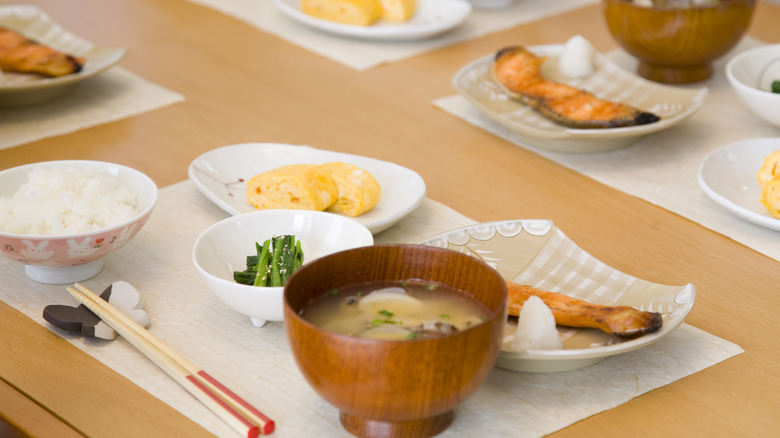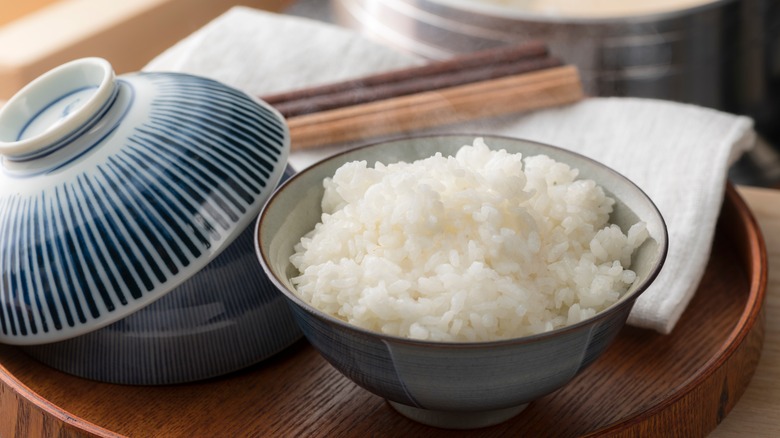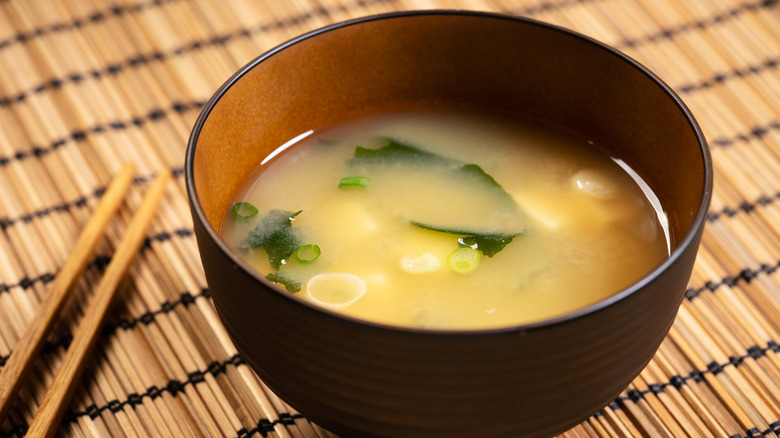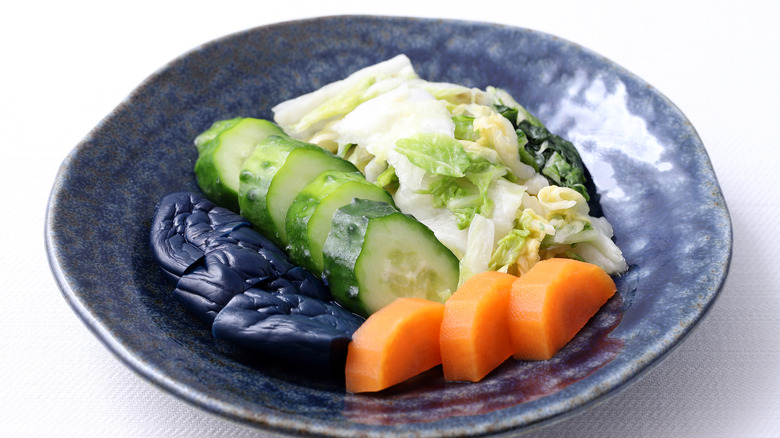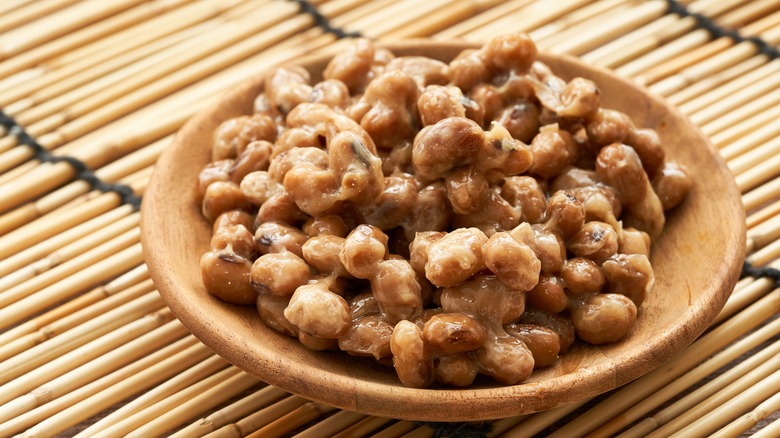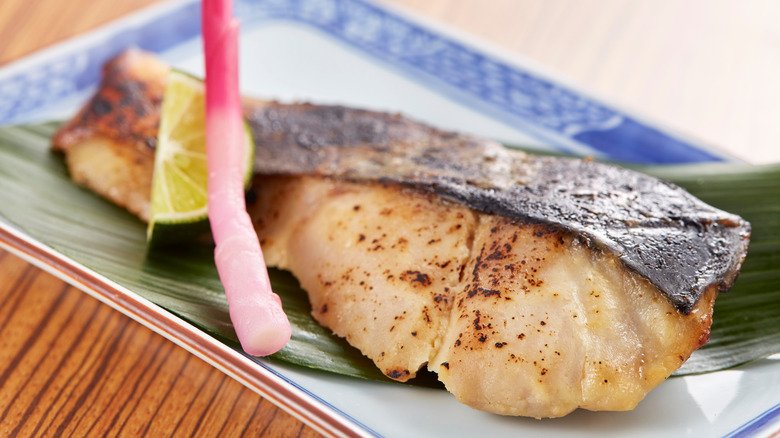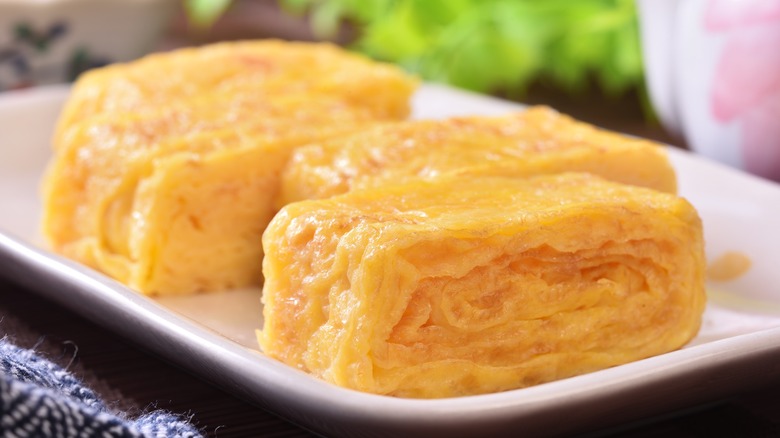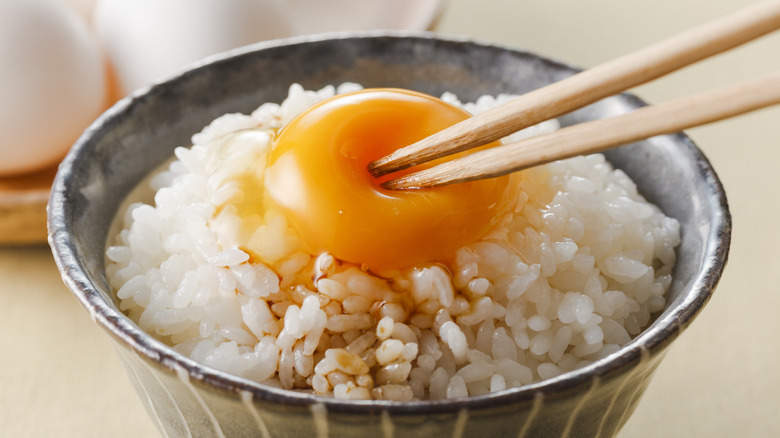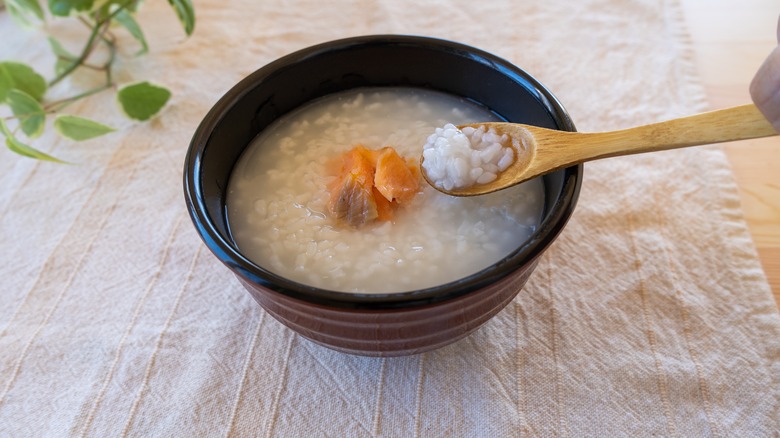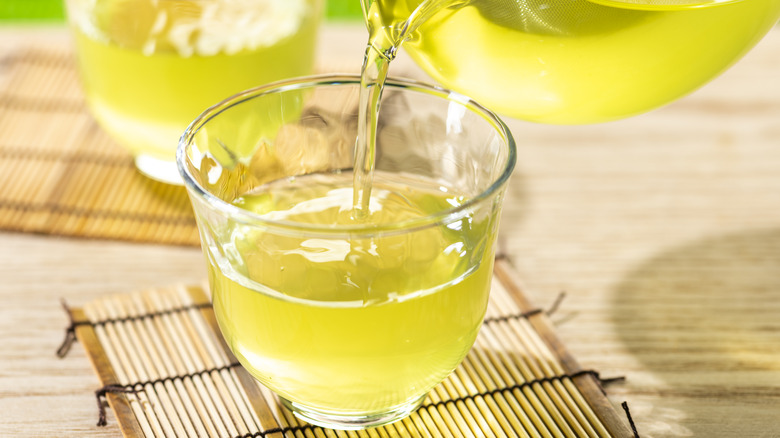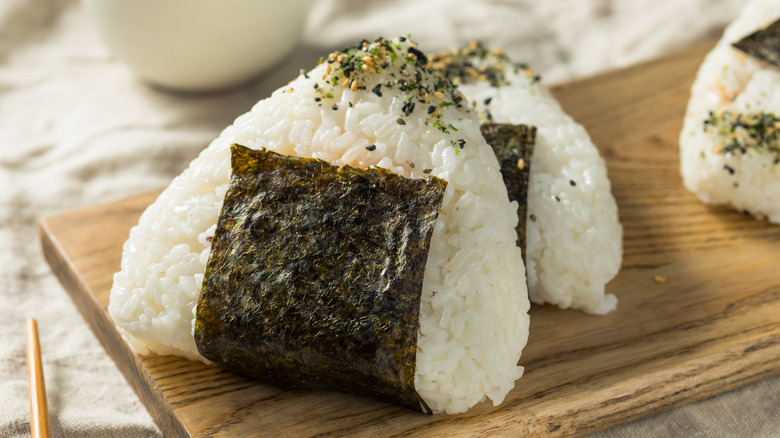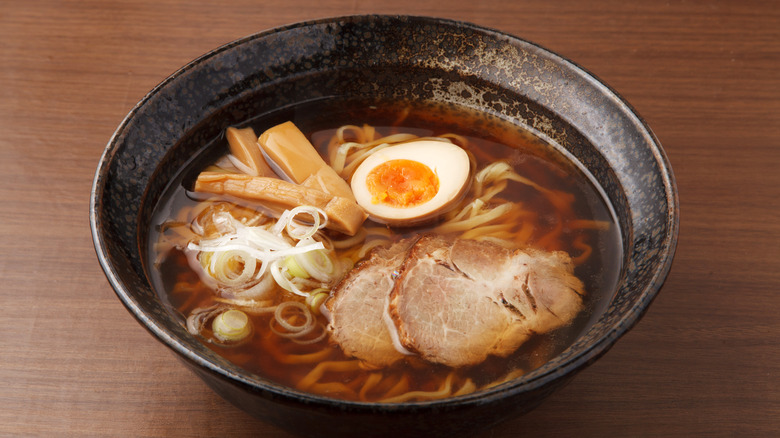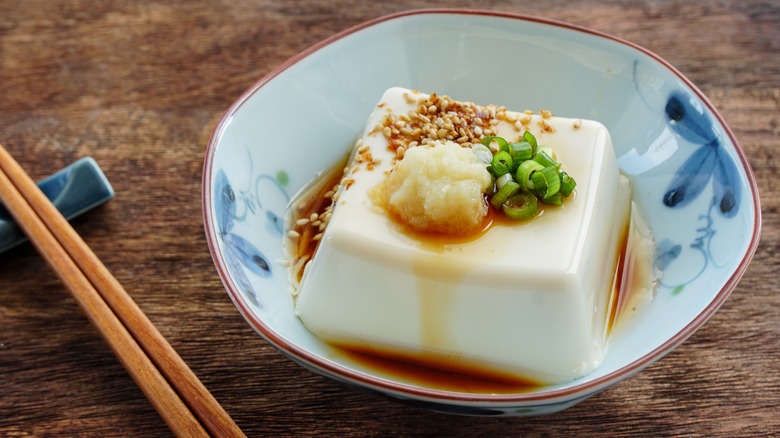The Ultimate Guide To Japanese Breakfast Foods
When most people think of Japanese food, they probably think of sushi or ramen. While it may not be as world-famous, breakfast also is an important part of Japanese cuisine. Japanese breakfasts are most commonly made at home, so they don't tend to be found on restaurant menus. However, some people — such as those who stay at a Japanese inn called a ryokan or a family-run home called minshuku — have the chance to be served a Japanese breakfast.
This meal is usually made up of savory foods, making it a comforting start to the day. Japanese breakfast also utilizes an idea called ichiju sansai, which means "one soup, three sides." Per this idea, Japanese breakfasts usually consist of four dishes. But this can vary.
Another important characteristic of Japanese cuisine — including Japanese breakfast — is the use of local foods and seasonal produce. This means that a breakfast served in a city like Osaka is going to be different from one served in Kagoshima. But this variety makes things all the more enjoyable.
Gohan (ご飯) – steamed rice
Perhaps the most important and ubiquitous food staple across all of Japan is rice. The grain even features in Japanese mythology and folklore. Throughout the country, around 300 different varieties of rice are grown. The whole grain is then used in everything from sushi to mochi.
Japanese rice can be served at any time of day, including during breakfast. Most Japanese varieties are known for having short grains that stick together well when cooked correctly. The resulting clumpy rice is easier to eat with chopsticks. A bowl of freshly steamed rice is an essential part of a traditional Japanese breakfast, similar to the way that an American breakfast includes toast.
Breakfast rice is usually served plain, since it is meant to be eaten with other breakfast dishes. However, the rice can also be sprinkled with a Japanese seasoning mixture called furikake. Common furikake ingredients include seasoned flakes of nori seaweed, a sharp-tasting herb called shiso, and roasted sesame seeds. There are several different kinds of furikake. During breakfast, furikake is normally served separately, so people can apply as much as they want.
Miso shiru (味噌汁) – miso soup
Miso soup is known for being a warm, savory dish. But in addition to being comforting, it's also somewhat nutritious. Its healthful properties include the presence of B vitamins and protein in each serving, according to WebMD. However, miso soup is often prepared with quite a bit of sodium, so it's best enjoyed in moderation.
Miso soup is served throughout the day in Japanese cuisine. It has long been considered a breakfast food, though — there are even reports of samurai eating it for the first meal of the day. It is commonly presented as a starter course.
In Japanese homes, miso soup is usually made from scratch. But don't be too alarmed, this recipe is pretty simple and only requires a handful of ingredients. One of them is miso paste. This component is made from fermented soybeans. It comes in several varieties, including light, white, and red miso. The soup's broth comes together using foods like dashi, a type of fish stock. Other ingredients like scallions or tofu may also be added to miso soup.
Tsukemono (漬物) – pickles
Japanese pickles — or tsukemono, as the food is called — are another dish enjoyed throughout the day in Japan. Like miso soup and rice, tsukemono is a popular side dish.
Tsukemono is made from a wide range of vegetables. Foods like ginger, carrot, eggplant, and daikon radish are some popular ingredients used in making these pickles. They can either be eaten with rice or enjoyed as a palate cleanser.
There are different types of tsukemono, all with unique preparation methods. The simplest varieties are made only with salt. But the pickles can also be made using ingredients like rice bran, soy sauce, or miso. Two popular types of tsukemono are umeboshi (pickled plums) and takuan (sliced, sun-dried daikon radish). There are also rarer forms of tsukemono that are considered regional dishes. These include Kyoto's shibazuke (eggplant and cucumber) and Matsumae Town's matsumaezuke (squid and kombu, a type of seaweed).
Natto (納豆) – fermented soybeans
Natto is another Japanese breakfast dish that is traditionally eaten with rice. You wouldn't expect as much based on its intense smell, but natto's taste isn't that strong. When eaten with rice, the flavor is made milder. Of course, Japan isn't the only country with strong-smelling foods. In Italy, there is gorgonzola cheese. In China and Taiwan, there is the appropriately-named "stinky tofu." The smell of natto is too much for some people. However, there are other reasons to consider trying it.
This breakfast food is also considered nutritious. According to Farmer's Almanac, it is high in several vitamins and minerals. Natto contains particularly high levels of vitamin K2. Consuming this nutrient may be beneficial to one's bone and heart health. Natto is also a fermented food made from soybeans. This means it contains probiotics, which are known for their numerous health benefits. According to Healthline, some of these are improvements to digestion, mental health, and the immune system.
Yakizakana (焼き魚) – grilled fish
Grilled fish — called yakizakana — is another food that is part of a traditional Japanese breakfast. If prepared correctly, yakizakana will be salty and crispy at the edges. Salmon is often the fish of choice in making it, as its vibrant pink-orange hue adds both color and flavor to the meal. However, the fish chosen for this element varies with both season and location. Fish like mackerel or saury are some other popular options.
Like other Japanese breakfast foods, yakizakana is a simple dish that lets the flavor of its ingredients shine. Also in line with similar dishes, yakizakana is enjoyed with rice. However, the dish's portion size is uniquely small. Instead of centering the meal around one large fish — such as in American cuisine — yakizakana is treated as a side dish in Japan. This is because, during this breakfast or other meals, most dishes are considered equally important.
Tamago (卵) – eggs
Eggs are a popular breakfast food in countries all over the world. Japan is no exception. One famous Japanese egg dish is tamagoyaki. It is made from beaten eggs seasoned with soy sauce and mirin (a type of sweet rice wine used for cooking). During preparation, the eggs are gently cooked and not allowed to turn brown. Then, the fluffy omelet is carefully folded into a rectangular block. Just before serving, the omelet is sliced into small pieces. Sometimes, tamagoyaki is also used as a sushi filling.
Another popular Japanese egg dish is onsen tamago. Like some of the aforementioned dishes, this food is often a part of breakfast at Japanese inns. It consists of a boiled egg. In making onsen tamago, the egg is cooked low and slow, giving it a softer finished texture. During breakfast, these eggs are served with soy sauce, dashi stock, and mirin.
Tamago kake gohan (卵かけご飯) – egg and rice bowl
For days when you want a hot and filling Japanese breakfast dish, tamago kake gohan is a great choice. This food is made by simply cracking a raw egg onto a bowl of hot rice.
It's recommended that you use piping hot rice when making tamago kake gohan. That way, when you mix in the raw egg, it cooks slightly. This part is pretty important. Raw eggs are known to carry bacteria such as salmonella that could cause food poisoning if consumed. Following this step won't necessarily prevent you from getting sick, but it could help a bit. Overall, there is less concern over contracting salmonella from raw eggs in Japan. According to Tsunagu Japan, this is because there are strict laws regulating poultry farms in the country. These rules help to protect the eggs from disease long before they end up at the grocery store. But if you are buying eggs to make tamago kake gohan outside of Japan, they may not be as safe to consume raw.
The basic version of tamago kake gohan contains only one egg and some rice. But many people add other ingredients, such as soy sauce, furikake, or spring onions.
Okayu (お粥) – rice porridge
Okayu is a type of rice porridge that has been around for approximately 1,000 years. It's similar to the Chinese dish congee. In the Kanto region of Japan, okayu is treated like American chicken soup and served to the sick. But in the Kansai region — which is home to cities like Osaka — okayu is a common breakfast food.
This porridge is prepared in a clay pot called a donabe. A mixture of around five parts water and one part rice is added. This mixture is simmered until the dish reaches a smooth consistency. Sometimes, toppings such as herbs are added. Finally, the dish is served in a bowl and eaten with a large, ceramic spoon called a renge.
Zosui is a dish similar to okayu. Instead of water, it's made with dashi, a stock usually made from kelp. Ochazuke is a similar dish, made from tea and rice. You can finish this dish with toppings like salmon, umeboshi, salted cod roe, or even Korean kimchi.
Sencha (煎茶) – green tea
No Japanese meal, including breakfast, is truly complete without tea. A particularly popular variety of Japanese tea is called sencha. Sencha accounts for approximately 75% of all Japanese green tea production. It contains a bright flavor well-suited to the morning. Sencha also usually contains caffeine, which can help get your day started, as well.
A common mistake made when brewing some kinds of tea, including Japanese ones like sencha, is using boiling water. This will ruin the flavor of the tea and give it a bitter taste. For the best results, sencha should be prepared with water that is around 160 degrees Fahrenheit. This is a particularly low temperature for tea. In comparison, black tea, white tea, and oolong tea are all recommended to be made with water that is at least 175 degrees Fahrenheit. A good cup of sencha is an essential part of a traditional Japanese breakfast. Just make sure it's properly brewed.
Onigiri (おにぎり) – rice balls
It is believed that onigiri has been a part of Japanese cuisine for around 2,000 years. Many of the onigiri recipes enjoyed centuries ago are still enjoyed today, like onigiri with umeboshi. This food was reportedly eaten by samurai during Japan's Kamakura period. The name onigiri is an umbrella term used for many rice-based Japanese snacks.
This portable rice ball dish is one you could consider the sandwich of Japan. You can easily make onigiri at home, or find prepared versions in stores. Also, like sandwiches, onigiri works great as a grab-and-go type of food. This Japanese breakfast dish consists of rice, a filling, and a wrapper of nori (seaweed) sheets. Foods like tuna, mentaiko (spicy fish roe), and salmon are commonly used for onigiri filling. This food can also be eaten as a sit-down meal, where it goes well with a bowl of miso soup and pickled vegetables.
Asa-rah (朝ラー) – morning ramen
Ramen isn't usually thought of as breakfast food, even in Japan. This is because the food is so rich, making it more suited to meals such as dinner. However, morning ramen (called Asa-rah ramen) has become a popular breakfast dish among one specific group of people: Japanese tea farmers. During harvest seasons, these farmers start work before dawn, waking up as early as 3 a.m. Eating a filling bowl of ramen for breakfast keeps workers energized throughout the workday. Thanks to them, morning ramen is becoming more popular.
Asa-rah ramen is usually made from a soy sauce base. This style of ramen, called shoyu, can be lighter than other types of ramen such as those made from a meaty broth. Shoyu ramen also tends to contain less oil, which could make it more appetizing to those looking to eat this food for breakfast. Morning ramen usually comes in two varieties: hot or cold. The cold version of this ramen is sometimes served with ingredients like wasabi and ginger.
Kobachi (小鉢) – side dishes
Kobachi is an umbrella term indicating a variety of side dishes sometimes served as part of a Japanese breakfast. This is fitting since the term kobachi means "small bowl." Hiyayakko is an example of one type of kobachi. It consists of a block of cold tofu seasoned with soy sauce, ginger, spring onions, and more. The type of tofu used for this dish is silken tofu. It has a faintly nutty flavor and a smooth texture that is similar to yogurt.
There are also several kobachi dishes made from vegetables. When prepared, some of the dishes are cooked to follow the style of a particular Japanese region. They are also driven by the seasons. These dishes are usually cooked through steaming. However, they could also be sautéed or served raw. These vegetable dishes are strategically chosen and prepared so that they will go well with rice.
